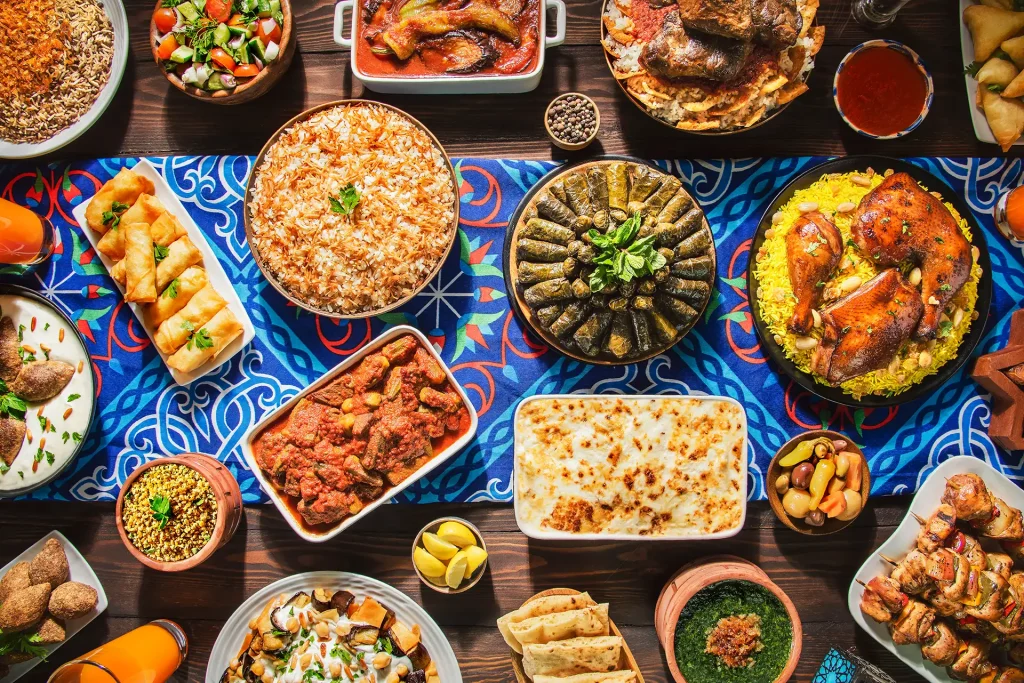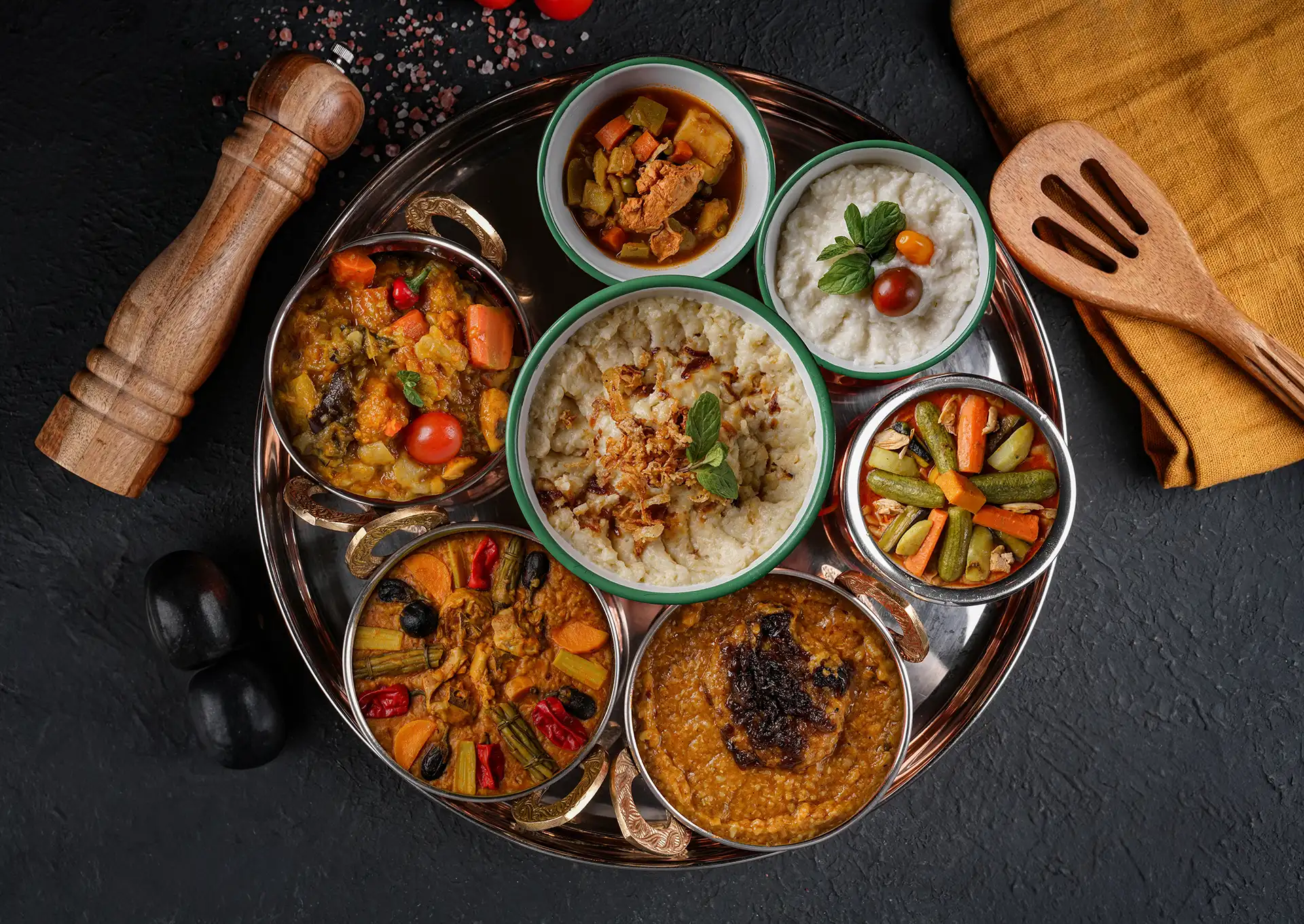Saudi Arabia’s rich culinary heritage is a reflection of the country’s diverse landscapes, cultural traditions, and history. As a result, Saudi Arabia prides itself on cuisine that is bold, with rich flavors, a blend of aromatic spices, and family-style cooking to bring people together.
In this blog, we’ll walk you through what you can expect from traditional food in Saudi Arabia, the history and influences behind these dishes, and how Saudi Arabian food varies in different regions.
Saudi Arabian Food: A Historical Perspective
Over the course of time, Saudi Arabian cuisine has continuously evolved. From ancient civilization, nomadic influences, and the widespread adoption of Islam across the country, culinary traditions have been shaped by trade and cultural exchange.
For example, key ingredients such as bulgur wheat date back to as early as 4,000BC, and still remain an integral part of the Saudi diet. From there, the Bedouin tribes introduced a nomadic lifestyle, whereby easily transportable foods such as dates, dried meats, and dairy became popular. It was also during this period that family-style cooking and eating together became a valuable tradition for the Saudi people; as it still is today.
Finally, with the emergence of Islam in the 7th century, trade flourished, and the Arabian Peninsula became a major hub for pilgrims. As a result, new ingredients, such as rice, were introduced to the region, while others, like pork, were prohibited under Islamic dietary laws.
Key Influences on Saudi Cuisine
The following factors have all played a key part in shaping Saudi Arabia’s food culture and cuisine into what it is today.
Geographic diversity
Saudi Arabia’s extraordinary geography ranges from scenic coastlines to mountains and scorching deserts. Because of this, each region has access to different ingredients that reflect the conditions of each environment. For example, coastal towns will specialize more in seafood dishes, while desert regions rely more on grains, meats, and dairy.
Historical trade routes
The Arabian Peninsula’s strategic location made it a key trading hub for regions such as Persia, India, and the Mediterranean, leading to a greater use of flavorful herbs and spices in its cuisine.
Islamic laws
As touched upon, the introduction of Islam has had a profound impact on traditional food in Saudi Arabia. Alongside the prohibition of pork and alcohol, all animals must be slaughtered according to halal practices.
Influence from neighboring countries
Saudi Arabia shares culinary similarities and has taken inspiration from neighboring countries, such as Yemen, Egypt, Oman, and the United Arab Emirates (UAE). Because of these cultural exchanges, Saudi Arabia has a fusion of flavors and dishes all around the country.
Importance of Hospitality
Since the Bedouin tribe era, hospitality has been an extremely important part of Saudi culture. As such, hosts are proud to serve their guests Saudi traditional food, dates, and Arabian coffee as a gesture of respect and generosity.

Popular Traditional Saudi Dishes
Main Dishes
- Kabsa – A flavorful mixed rice dish made with basmati rice, meat, vegetables, and a blend of spices. Often, the ingredients within Kabsa vary from region to region, but overall it is considered to be the national dish of Saudi Arabia.
- Jareesh – Originating from the Arabian Peninsula, Jareesh is a Saudi traditional food that is made of crushed wheat dish and slow-cooked with meat, onions, and spices.
- Mandi – Inspired by the Bedouin style of cooking, Mandi is made with rice, meat, and a blend of spices and is traditionally cooked in an underground clay oven.
- Saleeq – Saleeg is a creamy, rice dish typically made with chicken and milk. It is typically eaten in the Hejaz region in western Saudi Arabia.
Bread and Side Dishes
- Tamees – A traditional Saudi flatbread that is often freshly baked every day and is enjoyed with honey and ghee for breakfast, or served alongside dips, curries, and stews throughout the day.
- Markook – Baked on a convex metal griddle, Markook is a traditional thin, whole-wheat flatbread that is popular in many neighboring countries in the region.
Snacks & Street Food
- Mutabbaq – A stuffed savory pancake filled with spiced meat, eggs, and vegetables, which has become a staple street food in Saudi Arabia.
- Sambousa – A popular snack in the Gulf countries and India, a sambousa is a deep-fried or baked pastry pocket stuffed with spiced meat, cheese, or vegetables. It is especially popular during Ramadan.
- Shawarma – A beloved Middle Eastern street dish, Shawarma has become increasingly popular in Saudi Arabia. It consists of thinly sliced, marinated meat cooked on a vertical rotisserie. Shawarma is served in pita bread with various toppings, such as pickles, tomatoes, cucumbers, and tahini sauce.
Desserts & Sweets
- Maamoul – Known as an ancient cookie that ushers in Eid in Saudi Arabia, Maamoul is a shortbread cookie that is traditionally stuffed with date paste and is sometimes accompanied by chopped walnuts or pistachios.
- Luqaimat – The ‘Middle Eastern crunchy doughnut’ has become a famous dessert in Saudi Arabia and beyond. These deep-fried dough balls are drizzled with syrup or honey and are a popular treat during Ramadan.
- Kleija – A traditional round or oval Arabian pastry that is pressed with unique patterns before baking. The filling varies but commonly includes dates, sugar, or honey molasses, with spices such as cardamom and cinnamon.

Traditional Beverages
- Arabic coffee – Arabic coffee is an important symbol of hospitality in Saudi Arabia. It is a lightly roasted coffee brewed with cardamom, sometimes infused with saffron or cloves for added flavor, and is traditionally served in small cups alongside dates.
- Red Sobia (Sobia Hamra) – A traditional drink from the Hejaz region of Saudi Arabia, commonly consumed during Ramadan. It is made from soaked and blended bread or barley, mixed with sugar, water, and spices such as cinnamon and cardamom. Red Sobia gets its distinct color from hibiscus or raspberry, giving it a sweet, tangy, and slightly spiced flavor.
- Tamr Hindi (Tamarind Juice) – Recognized for its sour taste, tamarind juice is a popular beverage that is prepared by breaking open the tamarind fruit, before soaking it in water and sifting it.
Regional Variations in Saudi Cuisine
In 2024, the Saudi Culinary Arts Commission formally named regional dishes for all 13 provinces, showcasing the distinct diversity of cuisine in each region – which we have highlighted below.
Western Region
Including cities such as Makkah and Madinah, the Hijaz region is famous for Saleeg, a creamy rice meal cooked with milk and served with roasted meat. Madini Rice, a white steamed rice topped with tender meat in a rich, flavorful broth, is also popular in Madinah.
Central Region
Home to heart and robust dishes, cuisine in the Central region (Najd) includes Margaouq, a stew featuring meat, vegetables, and whole wheat dumplings that absorb rich flavors. Kleija, a spiced cookie, and Kubaibat Hail, a traditional rice and meat dish, are also popular in this region.
Aseer & Southern Region
The southern regions, including Asir, offer dishes like Haneeth, where meat is seasoned and slow-cooked until tender, often served with rice. Ruqsh, small pieces of whole wheat bread soaked in meat broth, is another traditional meal. Additionally, in Jazan, Maghsh is the region’s dish of choice, which is slow-cooked meat prepared in a stone pot, before being salted and immersed in water. In South-Western Saudi Arabia, Muqana bread, a traditional flatbread unique to Al Bahah, is also a staple side dish.
Northern Region
Culinary traditions in the north feature dishes such as Mulayhiya, consisting of rice, meat, and meat broth, with dried yogurt, garnished with parsley and pine nuts. Kabsa, like other regions, is also very popular here.
In Tabouk, Sayadiyah is a well-known specialty made from seasoned rice and fish, often topped with nuts for an added crunch.
Eastern Province Cuisine
Due to its coastal location, the Eastern Province offers seafood specialties and dishes like Hassawi Rice, distinguished by its red-colored grains. The region’s cuisine also features a variety of spices and herbs which is reflective of its historical trade connections.In Al Houf, Bukayla was formally named the regional dish, which is a sweet treat made by kneading together dates and Al-Samh seeds.
The Future of Saudi Cuisine
As part of Saudi Arabia’s Vision 2030 initiative to boost tourism and hospitality, the country is likely to continue investing in high-end restaurants where visitors can fully immerse themselves in the national food of Saudi Arabia.
As a whole, culinary tourism is extremely popular around the world, and Saudi Arabia is positioning itself as a key destination for food enthusiasts who want to celebrate its rich culinary heritage.
Conclusion
From unique flavors to comforting dishes, Saudi Arabia’s cuisine is a reflection of the country’s rich history and evolution. With a huge variety of dishes that are inspired by Saudi roots and Middle-Eastern culture, there’s something for everyone to try.
Next time you land in the Kingdom, make sure to try at least one of the dishes mentioned in this blog – or maybe even all of them if you’re feeling adventurous.
Frequently Asked Questions (FAQs)
Nationally, Kabsa is one of the most popular foods in Saudi Arabia, which is why it is considered to be the national dish. However, other traditional Saudi Arabian famous food is Haneeth, Jareesh, and Saleeq.
Traditional food varies across each region, however, some staple dishes other than those mentioned also include Hummus, Falafel, Foul Medames, and Maqluba.
When in Saudi Arabia, it is important to follow cultural and religious etiquette. For example, this includes respecting Islamic laws and avoiding food waste by taking only as much as you can eat.
